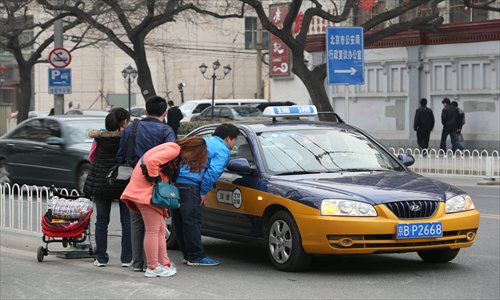Cabbie Rejoice!

Potential customers talk with a Beijing taxi driver. A new fare increase, which went into effect Monday, may help passengers more easily secure a ride. Photo: CFP
Tomi, a German businessman in Beijing who gave his first name only, first noticed the taxi fare increase when he hopped into a cab Tuesday night.
"It used to cost 35 yuan from the Olympic Center to Sanlitun; now it costs around 50 yuan," he told Metropolitan. "But the new price is totally acceptable."
Beijing taxi drivers question whether the rate increase will drive customers away or make traffic jams less of a burden for them. Riders, on the other hand, wonder if this will make finding a cab in the capital less problematic.
Tomi, for one, still finds drivers unwilling to pick him up.
"The problem is that I still find it very hard to get taxis when I need to go to some inconvenient areas like [Daxing district]," he said. "The taxi driver still turned me down."
The new rate policy kicked in on Monday. On Thursday, 20,000 out of the city's 66,000 taxis had the new meters installed. All taxis will use the new rate by July 1. Taxis with the new rate can be identified by blue stickers on their windows reading 2.3; old ones are red stickers and read 2.
The starting price for trips within 3 kilometers has risen from 10 to 13 yuan ($1.63 to $2.12) and the price per kilometer beyond that rose from 2 to 2.3 yuan. The fuel surcharges of 1 yuan will be uniformly applied to all trips, whereas previously, trips within 3 kilometers were exempt and past that incurred a surcharge of 3 yuan.
Five minutes of waiting or low-speed driving (less than 12 kilometers per hour) during rush hours (7 am to 9 am and 5 pm to 7 pm) now tacks on 2 kilometers (4.6 yuan), compared to the previous 1 kilometer (2 yuan).
With the new policy, a taxi ride from Baiziwan to Sanlitun, around 8 kilometers, has risen from 23 yuan to 26 yuan - in smooth traffic. A trip from Yonghegong Lama Temple to Guomao - around 9 kilometers - rose from 25 to 27.8 yuan.
Wang Hejie, a driver at Xinyue Taxi Company, welcomes the new rates because it means more income for him. He used to sleep to avoid the morning gridlock, but after installing the new meter Friday, he plans to "seize the rush hours."
"The increased prices decrease the difference between what I earn in good and bad traffic," he said.
He'll be a discriminating driver nonetheless by using the mobile app Dididache to pick the most profitable routes. For example, Wang said that even with the rate increase, he'll avoid picking up long-distance passengers like Tomi who want to go to inconvenient areas during rush hour. "The increased price per kilometer makes little difference when considering the empty trip back," he said.
Drivers were eager to install the new meters. "I could have earned more if I had installed it the first day," said cabbie Zheng Shanwen from Jingyuan company. "But we're a small company. The government installed meters for the big companies first."
American expat Ryan Fenwick approves of the rate hike. "It's important to ensure that drivers can [earn] enough," he said. "They provide a very important service."
Think the hike is too much? Consider your alternatives:
Maintaining a car for one year:
97,500 yuan to buy, fuel, insure, park and maintain a 2008 Toyota from a Huaxiang dealership, Fengtai district
Renting a car (Hyundai sedan) and driver for one month:
9,000 yuan
Renting a car for one month:
600 yuan, including the insurance and maintenance fees
Taking the subway to work and back for one month:
80 yuan
(Sources: He Shaobo, private car owner in Beijing, and a manager surnamed Li in Shengteng Car Lease Co.)